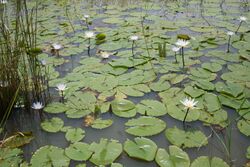Biology:Nymphaea micrantha
| Nymphaea micrantha | |
|---|---|

| |
| Scientific classification | |
| Kingdom: | Plantae |
| Clade: | Tracheophytes |
| Clade: | Angiosperms |
| Order: | Nymphaeales |
| Family: | Nymphaeaceae |
| Genus: | Nymphaea |
| Species: | N. micrantha
|
| Binomial name | |
| Nymphaea micrantha Guill. & Perr.[2]
| |
| Synonyms[3] | |
| |
Nymphaea micrantha is a water lily belonging to the genus Nymphaea. It is native to the tropics of West Africa.
Description
Its leaves are oval or round, 8-12 cm long, with a cluster of bulbils on the top of the leaf stalk. Flowers can reach up to 10 cm in diameter, and appear from approximately September to October.[4] The plant usually grows to a height of 20–80 cm (8–32 inches). It cannot be grown emersed.[5]
Reproduction
Vegetative reproduction
New plantlets develop on the adaxial leaf surface through foliar proliferation. The development of those plantlets is halted, while the leaf is still attached. However, once the leaf is detached the plantlets develop fully.[6] In India, which is outside of this species natural range, it has been shown that Nymphaea micrantha predominantly reproduces asexually. In India it has been shown to lack any amount of genetic diversity.[7]
Cytology
The chromosome count is n = 14. The genome size is 889.98 Mb.[8]
Taxonomy
Publication
It was first described by Jean Baptiste Antoine Guillemin and George Samuel Perrottet in 1831.[3]
Natural hybridisation

Together with Nymphaea nouchali var. caerulea, Nymphaea micrantha forms the natural hybrid Nymphaea × daubenyana native to Chad.[9]
Etymology
The specific epithet micrantha, from the Greek mikros meaning small and anthos meaning flower, means small-flowered.[10][11][12]
Uses
Food source
Seeds of Nymphaea lotus and Nymphaea micrantha are eaten in Senegal.[citation needed]
References
- ↑ Diop, F. N. (2020). "Nymphaea micrantha". The IUCN Red List of Threatened Species. doi:10.2305/IUCN.UK.2020-3.RLTS.T140427320A140426357.en.
- ↑ International Plant Names Index. "Plant Name Details Nymphaeaceae Nymphaea micrantha Guill. & Perr.". http://ipni.org/ipni/idPlantNameSearch.do?id=605626-1&back_page=%2Fipni%2FeditSimplePlantNameSearch.do%3Ffind_wholeName%3DNymphaea%2Bmicrantha%26output_format%3Dnormal. Retrieved 7 March 2012.
- ↑ 3.0 3.1 "Nymphaea micrantha Guill. & Perr." (in en). Royal Botanic Gardens, Kew. http://www.plantsoftheworldonline.org/taxon/605626-1. Retrieved 1 July 2023.
- ↑ Jones, Michael (1994). Flowering plants of the Gambia. A.A. Balkema. pp. 20–21. ISBN 9054101970.
- ↑ "Profile on Plantfinder". http://www.aquaticplantcentral.com/forumapc/plantfinder/details.php?id=109. Retrieved 2008-01-02.
- ↑ Wiersema, John H. (1988). "Reproductive Biology of Nymphaea (Nymphaeaceae)". Annals of the Missouri Botanical Garden 75 (3): 795–804. doi:10.2307/2399367. https://www.biodiversitylibrary.org/partpdf/35833.
- ↑ Parveen, Seema; Singh, Nutan; Adit, Arjun; Kumaria, Suman; Tandon, Rajesh; Agarwal, Manu; Jagannath, Arun; Goel, Shailendra (2022). "Contrasting Reproductive Strategies of Two Nymphaea Species Affect Existing Natural Genetic Diversity as Assessed by Microsatellite Markers: Implications for Conservation and Wetlands Restoration". Frontiers in Plant Science 13: 773572. doi:10.3389/fpls.2022.773572. PMID 35371128.
- ↑ Chen, Fei; Liu, Xing; Yu, Cuiwei; Chen, Yuchu; Tang, Haibao; Zhang, Liangsheng (2017). "Water lilies as emerging models for Darwin's abominable mystery". Horticulture Research 4: 17051. doi:10.1038/hortres.2017.51. PMID 28979789.
- ↑ 9.0 9.1 "Nymphaea × daubenyana W.T.Baxter ex Daubeny" (in en). Royal Botanic Gardens, Kew. http://www.plantsoftheworldonline.org/taxon/928088-1. Retrieved 3 July 2023.
- ↑ Jamesbrittenia micrantha | CasaBio. (n.d.). Retrieved January 16, 2024, from https://casabio.org/taxa/jamesbrittenia-micrantha
- ↑ Libertia micrantha. (n.d.). New Zealand Plant Conservation Network. Retrieved January 16, 2024, from https://www.nzpcn.org.nz/flora/species/libertia-micrantha/
- ↑ Bridelia micrantha | PlantZAfrica. (n.d.). Retrieved January 16, 2024, from https://pza.sanbi.org/bridelia-micrantha
External links
Wikidata ☰ Q7071189 entry
 |




